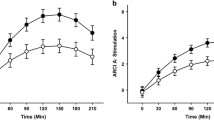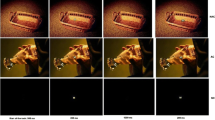Abstract
Deficits in response inhibition and error processing can result in maladaptive behavior, including failure to use past mistakes to inform present decisions. A specific deficit in inhibiting a prepotent response represents one aspect of impulsivity and is a prominent feature of addictive behaviors in general, including cocaine abuse/dependence. Brain regions implicated in cognitive control exhibit reduced activation in cocaine abusers. The purposes of the present investigation were (1) to identify neural differences associated with error processing in current and former cocaine-dependent individuals compared to healthy controls and (2) to determine whether former, long-term abstinent cocaine users showed similar differences compared with current users. The present study used an fMRI Go/No-Go task to investigate differences in BOLD response to correct rejections and false alarms between current cocaine users (n = 30), former cocaine users (n = 29), and healthy controls (n = 35). Impulsivity trait measures were also assessed and compared with BOLD activity. Nineteen regions of interest previously implicated in errors of disinhibition were queried. There were no group differences in the correct rejections condition, but both current and former users exhibited increased BOLD response relative to controls for false alarms. In current users, the pregenual cingulate gyrus and left angular/supramarginal gyri overactivated. In former users, the right middle frontal/precentral gyri, right inferior parietal lobule, and left angular/supramarginal gyri overactivated. Overall, our results support a hypothesis that neural activity in former users differs more from healthy controls than that of current users due to cognitive compensation that facilitates abstinence.
Similar content being viewed by others
References
Aron, A. R., Fletcher, P. C., Bullmore, E. T., Sahakian, B. J., & Robbins, T. W. (2003). Stop-signal inhibition disrupted by damage to right inferior frontal gyrus in humans. Nature Neuroscience, 6(2), 115–116.
Beveridge, T. J. R., Gill, K. E., Hanlon, C. A., & Porrino, L. J. (2008). Review. Parallel studies of cocaine-related neural and cognitive impairment in humans and monkeys. Philosophical Transactions of the Royal Society of London. Series B, Biological Sciences, 363(1507), 3257–3266.
Bolla, K. I., Cadet, J.-L., & London, E. D. (1998). The neuropsychiatry of chronic cocaine abuse. The Journal of Neuropsychiatry and Clinical Neurosciences, 10(3), 280–289.
Bolla, K. I., Ernst, M., Kiehl, K., Mouratidis, M., Eldreth, D., Contoreggi, C., et al. (2004). Prefrontal cortical dysfunction in abstinent cocaine abusers. The Journal of Neuropsychiatry and Clinical Neurosciences, 16(4), 456–464.
Botvinick, M. M., Cohen, J. D., & Carter, C. S. (2004). Conflict monitoring and anterior cingulate cortex: an update. Trends in Cognitive Sciences, 8(12), 539–546.
Braver, T. S., Barch, D. M., Gray, J. R., Molfese, D. L., & Snyder, A. (2001). Anterior cingulate cortex and response conflict: effects of frequency, inhibition and errors. Cerebral Cortex, 11(9), 825–836.
Carter, C. S. (1998). Anterior cingulate cortex, error detection, and the online monitoring of performance. Science, 280(5364), 747–749.
Carter, C. S., & Van Veen, V. (2007). Anterior cingulate cortex and conflict detection: an update of theory and data. Cognitive, Affective & Behavioral Neuroscience, 7(4), 367–379.
Carver, C. S., & White, T. L. (1994). Behavioral inhibition, behavioral activation, and affective responses to impending reward and punishment: the BIS/BAS Scales. Journal of Personality and Social Psychology, 67, 319–333.
Cervantes, M. C., Laughlin, R. E., & Jentsch, J. D. (2013). Cocaine self-administration behavior in inbred mouse lines segregating different capacities for inhibitory control. Psychopharmacology, in press.
Chamberlain, S. R., & Sahakian, B. J. (2007). The neuropsychiatry of impulsivity. Current Opinion in Psychiatry, 20(3), 255–261.
De Wit, H. (2009). Impulsivity as a determinant and consequence of drug use: a review of underlying processes. Addiction Biology, 14(1), 22–31.
Decary, A., & Richer, F. (1995). Response selection deficits in frontal excisions. Neuropsychologia, 33(10), 1243–1253.
Drewe, E. A. (1975). Go-no go learning after frontal lobe lesions in humans. Cortex, 11, 8–16.
Eagle, D. M., & Robbins, T. W. (2003). Inhibitory control in rats performing a stop-signal reaction-time task: effects of lesions of the medial striatum and d-Amphetamine. Behavioral Neuroscience, 117, 1302–1317.
Fillmore, M. T., & Rush, C. R. (2002). Impaired inhibitory control of behavior in chronic cocaine users. Drug and Alcohol Dependence, 66(3), 265–273.
First, M. B., Spitzer, R. L., Gibbon, M., & Williams, J. B. W. (2002). Structured Clinical Interview for DSM-IV-TR Axis I Disorders, Research Version, Patient Edition (SCID-I/P). New York: Biometrics Research: New York State Psychiatric Institute.
Franken, I. H. A., Van Strien, J. W., Franzek, E. J., & Van de Wetering, B. J. (2007). Error-processing deficits in patients with cocaine dependence. Biological Psychology, 75(1), 45–51.
Freire, L., Roche, A., & Mangin, J. F. (2002). What is the best similarity measure for motion correction in fMRI time series? IEEE Transactions on Medical Imaging, 21(5), 470–484.
Garavan, H., & Hester, R. (2007). The role of cognitive control in cocaine dependence. Neuropsychology Review, 17(3), 337–345.
Goldstein, R. Z., & Volkow, N. D. (2002). Drug addiction and its underlying neurobiological basis: neuroimaging evidence for the involvement of the frontal cortex. The American Journal of Psychiatry, 159(10), 1642–1652.
Iverson, S. D., & Mishkin, M. (1970). Perseverative interference in monkeys following selective lesions of the inferior prefrontal convexity. Experimental Brain Research, 11, 376–386.
Kaufman, J. N., Ross, T. J., Stein, E. A., & Garavan, H. (2003). Cingulate hypoactivity in cocaine users during a GO-NOGO task as revealed by event-related functional magnetic resonance imaging. The Journal of Neuroscience, 23(21), 7839–7843.
Lejuez, C. W., Read, J. P., Kahler, C. W., Richards, J. B., Ramsey, S. E., Stuart, G. L., et al. (2002). Evaluation of a behavioral measure of risk taking: the Balloon Analogue Risk Task (BART). Journal of Experimental Psychology: Applied, 8, 75–84.
Li, C. R., Huang, C., Yan, P., Bhagwagar, Z., Milivojevic, V., & Sinha, R. (2008). Neural correlates of impulse control during stop signal inhibition in cocaine-dependent men. Neuropsychopharmacology, 33(8), 1798–1806.
Luo, X., Zhang, S., Hu, S., Bednarski, S. R., Erdman, E., Farr, O. M., et al. (2013). Error processing and gender-shared and -specific neural predictors of relapse in cocaine dependence. Brain, 136, 1231–1244.
Magno, E., Foxe, J. J., Molholm, S., Robertson, I. H., & Garavan, H. (2006). The anterior cingulate and error avoidance. The Journal of Neuroscience, 26(18), 4769–4773.
Mathalon, D. H., Whitfield, S. L., & Ford, J. M. (2003). Anatomy of an error: ERP and fMRI. Biological Psychology, 64(1–2), 119–141.
Meda, S. A., Stevens, M. C., Potenza, M. N., Pittman, B., Gueorguieva, R., Andrews, M. M., et al. (2009). Investigating the behavioral and self-report constructs of impulsivity domains using principal component analysis. Behavioural Pharmacology, 20(5–6), 390–399.
Mendez, I. A., Simon, N. W., Hart, N., Mitchell, M. R., & Nation, J. R. (2011). Impulsive choice in a delay discounting task. Behavioral Neuroscience, 124(4), 470–477.
Menon, V., Adleman, N. E., White, C. D., Glover, G. H., & Reiss, A. L. (2001). Error-related brain activation during a Go/NoGo response inhibition task. Human Brain Mapping, 12(3), 131–143.
Nestor, L., McCabe, E., Jones, J., Clancy, L., & Garavan, H. (2011). Differences in “bottom-up” and “top-down” neural activity in current and former cigarette smokers: Evidence for neural substrates which may promote nicotine abstinence through increased cognitive control. NeuroImage, 56(4), 2258–2275.
Patton, J. H., Stanford, M. S., & Barratt, E. S. (1995). Factor structure of the Barratt impulsiveness scale. Journal of Clinical Psychology, 51(6), 768–774.
Reynolds, B., & Schiffbauer, R. (2004). Measuring state changes in human delay discounting: an experiential discounting task. Behavioural Processes, 67(3), 343–356.
Rubia, K., Russell, T., Overmeyer, S., Brammer, M. J., Bullmore, E. T., Sharma, T., et al. (2001). Mapping motor inhibition: conjunctive brain activations across different versions of go/no-go and stop tasks. NeuroImage, 13(2), 250–261.
Sanavio, E. (1988). Obsessions and compulsions: the Padua inventory. Behaviour Research and Therapy, 26(2), 169–177.
Sobell, L. C., & Sobell, M. B. (1992). Timeline follow-back: A technique for assessing self-reported alcohol consumption. In R. Litten & J. Allen (Eds.), Measuring alcohol consumption: Psychosocial and biochemical methods (pp. 41–72). Totowa: Humana Press.
Stevens, M. C., Kiehl, K. A., Pearlson, G. D., & Calhoun, V. D. (2007). Functional neural networks underlying response inhibition in adolescents and adults. Behavioural Brain Research, 181(1), 12–22.
Stevens, M. C., Kiehl, K. A., Pearlson, G. D., & Calhoun, V. D. (2009a). Brain network dynamics during error commission. Human Brain Mapping, 30(1), 24–37.
Stevens, M. C., Skudlarski, P., Pearlson, G. D., & Calhoun, V. D. (2009b). Age-related cognitive gains are mediated by the effects of white matter development on brain network integration. NeuroImage, 48(4), 738–746.
Tapert, S. F., Schweinsburg, A. D., Drummond, S. P. A., Paulus, M. P., Brown, S. A., Yang, T. T., et al. (2007). Functional MRI of inhibitory processing in abstinent adolescent marijuana users. Psychopharmacology, 194(2), 173–183.
Torrubia, R., Ávila, C., Moltó, J., & Caseras, X. (2001). The Sensitivity to Punishment and Sensitivity to Reward Questionnaire (SPSRQ) as a measure of Gray’s anxiety and impulsivity dimensions. Personality and Individual Differences, 31(6), 837–862.
Volkow, N. D., Hitzemann, R., Wang, G. J., Fowler, J. S., Wolf, A. P., Dewey, S. L., et al. (1992). Long-term frontal brain metabolic changes in cocaine abusers. Synapse, 11(3), 184–190.
Volkow, N. D., Fowler, J. S., & Wang, G.-J. (2003). The addicted human brain: insights from imaging studies. The Journal of Clinical Investigation, 111(10), 1444–1451.
Watanabe, M. (1986). Prefrontal unit activity during delayed conditional Go/No-go discrimination in the monkey. II. Relation to Go and No-go responses. Brain Research, 382(1), 15–27.
Wechsler, D. (1997). Wechsler adult intelligence scale (3rd ed.). San Antonio: Psychological Corporation.
Wheeler, A. L., Lerch, J. P., Chakravarty, M. M., Friedel, M., Sled, J. G., Fletcher, P. J., et al. (2013). Adolescent cocaine exposure causes enduring macroscale changes in mouse brain structure. The Journal of Neuroscience, 33(5), 1797–1803.
Zuckerman, M., & Neeb, M. (1979). Sensation seeking and psychopathology. Psychiatry Research, 1(3), 255–264.
Acknowledgments
Funding for this study was provided by the National Institute on Drug Abuse by grant RO1 DA020709 to G. Pearlson.
Conflict of interest statement
The authors declare that they have no conflict of interest.
Author information
Authors and Affiliations
Corresponding author
Rights and permissions
About this article
Cite this article
Castelluccio, B.C., Meda, S.A., Muska, C.E. et al. Error processing in current and former cocaine users. Brain Imaging and Behavior 8, 87–96 (2014). https://doi.org/10.1007/s11682-013-9247-y
Published:
Issue Date:
DOI: https://doi.org/10.1007/s11682-013-9247-y




